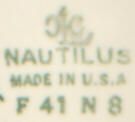 The Nautilus flatware is characterized as a plain round shape with a single sunken ring around the edge. On the other hand, the hollowware is ornate with shell finials and handles and little scroll feet. The Nautilus flatware is characterized as a plain round shape with a single sunken ring around the edge. On the other hand, the hollowware is ornate with shell finials and handles and little scroll feet.
Modeling of the line began in July 1935 with a 9" plate with a ,"deep ball, sunken bead, and a plain edge." Several other version were created, but the original design was accepted. From August to October, several casseroles were modeled: "Plain Sunken Bead", "Sunken Bead on Edge, Ring Handled" and "Sunken Bead, Plain Cover, Oval Handles." Ring handled sugars and creamers were then made to match the casserole.
On October 1935, the familiar Nautilus casserole was modeled and listed as, "Casserole Shell Handles Four Footed." With the basic shapes for the flatware and hollowware approved, the rest of Nautilus was made. The flatware was created with ease, however the same cannot be said for the hollowware. The casserole required several revisions so the shell handles would come out right in the finished product. The feet for the hollowware underwent several changes. On March 20, 1936, an entry in Frederick Rhead's journals discusses one of the problems with the hollowware" "...Nautilus cream. Casting holes in foot too prominent. This piece and the sauceboat to be taken care of..." On the same day an entry is made regarding the teapot which confirms what many collectors have suspected: "Pittenger phoned about Nautilus teapot. Told him that J. M. Wells had not included it in the line. He suggested the Wells teapot. Suggested that we decorate
one..." While Rhead doesn't mention the Wells teapot again, it must have been picked up since sets of Nautilus can be found with a Wells shape teapot.
Nautilus was offered in early 1936 and would continue to be produced into the mid to late 1950s. Almost every piece (except teacups and demitasse cups) will be marked with a special Nautilus backstamp which Rhead notes making on December 26, 1935.

Advertisement for "Early America" on the Nautilus shape
Besides the Wells teapot, some patterns had other pick up pieces included such as the Baltimore mug, Cable egg cup, and the Jade butter dish. They carry a general HLC backstamp with date code.
See also:
|